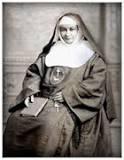- |
User Links
Mary Francis Cusack

www.en.wikipedia.org
| Short Name: | Mary Francis Cusack |
| Full Name: | Cusack, Mary Francis, 1832-1899 |
| Birth Year: | 1832 |
| Death Year: | 1899 |
[Cusack, Mary Francis., also known as Sister Mary Francis Clare, Religious of the Order of Poor Clares, Margaret Anna Cusack, C. F. Cusack, M. F. Cusack] Sister Mary F. Clare, of Kenmare, has written several hymns of merit, including:—
1. Before the throne of God above. Angels.
2. Hark, the angels bright are singing. Easter.
3. Jesus was once a little child. Jesus the Holy Example.
Of these Nos. 1, 3 are in Mrs. Brock's Children's Hymn Book, 1881, and No. 2 in W. G. Horder's Hymn Lover, 1889.
--John Julian, Dictionary of Hymnology, Appendix, Part II (1907)
=================
Clare, Mary F., p. 1556, ii. In the Standard of June 7, 1899, is the following: "June 5, at Leamington, Margaret Anna Cusack, only daughter of the late Samuel Cusack, M.D., of Dublin, aged 70." In the same paper on the following day, this lady is identified as "Sister Mary F. Clare," the Nun of Kenmare, who, on leaving the Roman Catholic Church, lectured extensively on Protestantism. The hymns noted on p. 1556, ii., are from her Hymns for Children by a Religious of the Holy Order of the Poor Clares, London, 1862. Two others in 1862 have passed into the Congregational Book of Praise for Children, 1881, "O gentle Jesus, had I been" (Christ blessing Children), and “When Jesus was on earth He used" (Jesus, the Healer). [Rev. James Mearns, M.A.]
--John Julian, Dictionary of Hymnology, New Supplement (1907)
| Texts by Mary Francis Cusack (4) | As | Authority Languages | Instances |
|---|---|---|---|
| Before the throne of God above, I have a strong, a perfect plea | M. F. Clare (Author) | English | 1 |
| Before the throne of God above The glorious angels stand | M. F. Clare (Author) | English | 3 |
| Hark, the angels bright are singing | Mary F. Cusack (Author) | English | 4 |
| Jesus was once a little child, A little child like me | Mary F. Clare (Author) | English | 12 |


 My Starred Hymns
My Starred Hymns


